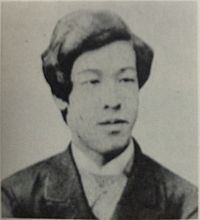Name Yamada Bimyo Died October 24, 1910 | Role Author | |
 | ||
Yamada Bimyo (山田 美妙), born Yamada Taketaro (山田 武太郎, 1868-1910), was a Japanese shosetsu author.
Contents
Jim Reichert, author of Yamada Bimyo: Historical Fiction and Modern Love, wrote that Bimyo was "one of the most influential literary reformers of the 1880s" who had "an instrumental role" in producing reikishi shosetsu, the modern form of a Japanese historical novel. According to Reichert, during the 1880s the public perceived Bimyo "to be at the forefront of the literary reform movement, offering a fresh and exciting strategy for reforming Japanese literature."
Louis Frederic, author of the Japan Encyclopedia, wrote that Bimyo was, along with Koda Rohan, "the most representative authors" of the first modern school of literature to appear in Meiji Japan.
History
Bimyo was a part of the "Ken'yusha" ("Friends of the Inkstone") literary group formed in February 1885, along with Ozaki Koyo, Ishibashi Shian, and Maruoka Kyuka.
Bimyo married the writer Tazawa Inabune (Tazawa Kin) after she traveled to Tokyo to meet him. At the time, Bimyo's financial situation was deteriorating, and Inabune's family was wealthy. Yukiko Tanaka, author of Women Writers of Meiji and Taisho Japan: Their Lives, Works and Critical Reception, 1868-1926, stated that the marriage would not have occurred if the financial situation did not exist.
During the marriage Bimyo had affairs with other women. Bimyo told Ozaki Koyo, who criticized his having affairs, that he did them to enhance his artistic abilities. The marriage attracted scrutiny from the press, and after three months they divorced and Inafune was forced to return home.
The man's relationships with his colleagues eventually deteriorated. Bimyo's ex-wife's died, and many newspapers reported that she committed suicide. Melek Ortabasi, author of "Tazawa Inabune (1874-1896)", wrote that Inafune's death ended Bimyo's career "in large part" because Bimyo received criticisms for how he had treated Inafune.
Bimyo died at age 42. At the time of his death he was in a poor economic situation. In 2006 Reichert stated that Bimyo had "faded into relative obscurity".
Writing style
Tomi Suzuki, author of Narrating the Self: Fictions of Japanese Modernity, wrote that Bimyo's writing style "was in fact far from the spoken languages of the time." Bimyo favored genbun-itchi (言文一致), which means unifying spoken and written language, and also used Western literature features including different grammatical persons, ellipses, passive voice, personification, and Western tense styles. He wrote an 1889 article advocating genbun-itchi.
